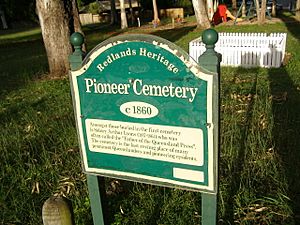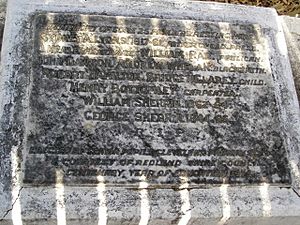Cleveland Pioneer Cemetery facts for kids
Quick facts for kids Cleveland Pioneer Cemetery |
|
|---|---|

Cleveland Pioneer Cemetery, signage, 2006
|
|
| Location | Lisa Street, Cleveland, City of Redland, Queensland, Australia |
| Official name: Cleveland No.1 Cemetery, Pioneer Cemetery, Cleveland Cemetery (No. 1) | |
| Type | archaeological |
| Designated | 18 September 2009 |
| Reference no. | 645608 |
| Significant period | 1858-1873 (historical use) |
| Lua error in Module:Location_map at line 420: attempt to index field 'wikibase' (a nil value). | |
The Cleveland Pioneer Cemetery is a special historical place in Cleveland, Queensland, Australia. It's also known as Cleveland No.1 Cemetery. This old cemetery is listed on the Queensland Heritage Register because it tells us a lot about the early days of settlement in the area. You can find it on Lisa Street in Cleveland, which is part of Redland City.
Contents
Discovering Cleveland's Past
The area around Cleveland was one of the first places in Queensland where people could settle freely. This happened after the Moreton Bay Penal Settlement closed in 1842. Many people hoped Cleveland would become the main port for the Moreton Bay area.
Cleveland was officially named a township in December 1850. The first pieces of land were sold in 1851. Early European settlers were often involved in farming, business, or shipping.
The First Cemetery
A spot for Cleveland's first cemetery was chosen in December 1858. It was located in an area now bordered by Wellington, Queen, Russell, and Smith Streets. The plan for the cemetery included separate sections for different religious groups. These included the Church of England, Presbyterians, Wesleyans, Roman Catholics, Jews, and "Various Denominations."
By 1864, Cleveland had about 145 people. Most worked as labourers, farmers, or timber-getters.
The cemetery was used until 1873. It was then decided that the ground was too "swampy" for burials. A new cemetery, Cleveland No.2, was opened right across Wellington Street.
Who Was Buried Here?
We know of 11 people buried in the Pioneer Cemetery between 1858 and 1873. These include:
- Bridget Clary, a child who died in 1860.
- Emily (Amelia) Hobbs, who died in 1860.
- Arthur Sidney Lyon, a journalist and editor, who died in 1861.
- William Henry Sherrin, a child who died in 1864.
- George Sherrin, who died in 1865.
- Robert Hamilton, who died in 1869.
- Henry Bottomley, a carpenter.
- John Dawson.
- J. Neale, a fisherman.
- William Rae, a publican.
- Andrew Whelan, a blacksmith.
We don't know the exact number of people buried here. It's also not known if any bodies were moved to the new Cleveland No.2 Cemetery.
Arthur Sidney Lyon: A Pioneer of the Press
One of the most important people buried here is Arthur Sidney Lyon. He died in Cleveland in 1861. He is sometimes called "The Father of the Queensland Press."
Lyon started the Moreton Bay Courier newspaper in 1846. This newspaper later became The Courier-Mail, which is still published today. He also started other newspapers like the Moreton Bay Free Press and the North Australian.
Protecting the Cemetery Site
By 1903, the original cemetery land was divided into smaller lots. However, the cemetery part was not sold because of its history. The Cleveland Shire Council strongly objected to selling or leasing the land. They believed that a place used as a cemetery should never be sold.
The council kept fighting to protect the site. Finally, in 1937, the cemetery area was officially made a protected reserve.
In 1975, a memorial was placed at the site. A teacher named Merv Beitz from Cleveland State School helped his students create it. The memorial lists the names of ten people known to be buried there. At the time, there were no headstones left.
What the Cemetery Looks Like Today
Today, the Cleveland Pioneer Cemetery is part of Scott Street Park. It's a grassy area with many large shade trees, mostly eucalyptus. You won't see any headstones or clear signs of graves.
There's a playground area in the park for kids. There's also a bench and a water tap nearby. These modern additions don't affect the historical importance of the site.
Near Lisa Street, you'll find the memorial plaque. It's on a white concrete base and surrounded by a white picket fence. The plaque lists the names of some of the pioneers buried there.
The plaque reads:
IN MEMORY OF SOME 25 PIONEERS RESTING HERE.
SYDNEY A. LYONS. 1816-61. FATHER OF QLD PRESS.
J. NEALE. FISHERMAN. WILLIAM RAE. PUBLICAN.
JOHN DAWSON. ANDREW WHELAN. BLACKSMITH.
ROBERT HAMILTON. BRIDGET CLAREY. CHILD.
HENRY BOTTOMLEY. CARPENTER.
WILLIAM SHERRIN. 1862-64.
GEORGE SHERRIN. 1844-66.ERECTED BY SENIOR PUPILS, CLEVELAND PRIMARY SCHOOL
COURTESY OF REDLAND SHIRE COUNCIL.
CENTENARY YEAR OF EDUCATION 1975.
There is also an information sign next to the memorial. It helps visitors learn more about the cemetery's history.
Why It's a Heritage Site
The Cleveland Pioneer Cemetery was added to the Queensland Heritage Register on September 18, 2009. This means it's recognized as an important part of Queensland's history.
It's important because it was the first cemetery in the Redlands area. This region was one of the first places in southeast Queensland to be settled freely. The cemetery is also historically important as the burial site of Arthur Sidney Lyon. He was known as "The Father of the Queensland Press" for starting early newspapers.
The memorial stone, put in place in 1975, shows how much the community cares about this site. The information sign also shows that people continue to remember and value this historical place.
Studying the cemetery more could help us learn new things about early settlement in the Redlands region. For example, looking at the ground could show us where graves were located. This might help us understand how the cemetery was organized. It could also tell us if any graves were moved to the later Cleveland No.2 Cemetery.
Learning about this cemetery helps us understand how people lived and were buried long ago. It gives us clues about the social structures of early European settlements in Queensland.


